new posts in all blogs
Viewing: Blog Posts Tagged with: Football, Most Recent at Top [Help]
Results 26 - 50 of 88
How to use this Page
You are viewing the most recent posts tagged with the words: Football in the JacketFlap blog reader. What is a tag? Think of a tag as a keyword or category label. Tags can both help you find posts on JacketFlap.com as well as provide an easy way for you to "remember" and classify posts for later recall. Try adding a tag yourself by clicking "Add a tag" below a post's header. Scroll down through the list of Recent Posts in the left column and click on a post title that sounds interesting. You can view all posts from a specific blog by clicking the Blog name in the right column, or you can click a 'More Posts from this Blog' link in any individual post.
.jpeg?picon=3306)
By: Zoe,
on 7/1/2014
Blog:
Playing by the book
(
Login to Add to MyJacketFlap)
JacketFlap tags:
Football,
Bullying,
Friendship,
School,
Emotions,
Sewing,
Knitting,
Colours,
Families,
Dressing up,
Margaret Chamberlain,
Personality,
Different perspectives,
Being independent,
Behaviour (good or bad),
Craig Pomranz,
Inclusive/diverse books,
Add a tag
Indulge me: Have a quick brainstorm about picture books you know for young kids which explore what it feels like to be different?
[Go on! Play the game!]
.
.
.
.
.
.
.
Of those you’ve come up with, how many are about emotions rather than physical characteristics?
How many of them feature humans rather than animals?
How many of them have a boy lead character rather than a girl?
[I came up with very few, and even then I needed help from the ever resourceful and generous Letterbox Library. Between us we came up with Oliver by Birgitta Sif, Eliot Jones, Midnight Superhero by Anne Cottringer and Alex T Smith, Weslandia by Paul Fleischman and Kevin Hawkes but that was pretty much it.]
 So when Made by Raffi written by Craig Pomranz, illustrated by Margaret Chamberlain (@madgiemadge) appeared in my hands for the first time I sat up and noticed; it’s about a boy who feels he doesn’t quite fit in, for instead of football, his passion is knitting and sewing.
So when Made by Raffi written by Craig Pomranz, illustrated by Margaret Chamberlain (@madgiemadge) appeared in my hands for the first time I sat up and noticed; it’s about a boy who feels he doesn’t quite fit in, for instead of football, his passion is knitting and sewing.
Although he’s a curious and generous kid, he feels sidelined at school. Unlike most of his classmates, he doesn’t like noise and rough play. But thanks to a supportive teacher he discovers a new passion – making his own clothes. When it is time for the school play could this new skill help him gain the respect of his peers? Without giving the game away, the ending is upbeat, but also authentic. This isn’t a sugar-coated story. (For the really interesting background to the story, take a look at this article).
This book deserves to be in every school and read in every family for a whole plethora of reasons. It’s bold, tackling gender issues that many adults might skirt around: I love Pomranz daring to use the word “girly“, and it certainly helped us talk about how being a girl interested in ‘boys’ things’ is often more accepted by society than a boy interested in ‘girls’ things’. It’s big hearted; not just the warm, loving family Raffi is part of, but also his supportive school. It shows all sorts of children playing together, with different skin colours and different physical abilities, as well as different interests. It’s a joyously inclusive book, which tackles big themes gently and playfully.

Margaret Chamberlain’s illustrations are delightful. She uses colour very cleverly to portray moods and to mirror how much more interesting – indeed colourful – the world is for a diverse range of characters; wouldn’t the world be a dull grey place if we all liked only the same things?
A book about loneliness, respect, difference, and learning to trust your instincts even when it means you don’t follow the crowd, Made by Raffi is a vital, delightful and unusual book I urge you to share.
M and J were recently shown how to knit by their Grandma, and reading Made by Raffi offered the ideal opportunity to practice their recently acquired skills. (Here are some Youtube tutorials we found helpful to refresh our memories of what Granny had taught us: Casting on, knit stitch, casting off.


Having a ball of wool with lots of different colours on it was an effective tool in motivating the kids; each child would knit one or two colours and then hand the needles and ball over to the other. It gave them easy targets to aim for, and I’m sure this is partly why they completed a long scarf far more quickly than I was expecting.

Whilst knitting we’ve been listening to:
Lots of songs by Raffi (an Egyptian-born Canadian singer-songwriter who creates great kid-friendly music), – here’s a whole playlist on youtube.
The Knitting Song by Bill Oddie
Knitting by Arthur Askey. Massively old fashioned but a great rumble through all sorts of stitches and garments.
Other activities which would go well with reading Made by Raffi include:
Learning to finger knit. Here’s the youtube video we used to learn how to fingerknit.
Letting the kids embellish their own clothing. I found this the easiest/most satisfying way to let the kids have a go at making something themselves – they chose buttons they liked and sewed them onto a couple of pieces of clothing. Simple sewing but with a relatively big (and ‘real’) result.
Making a cloak as described in the story. Alternatively, if you can find a department store selling off curtain samples (eg in John Lewis or House of Fraser), you can pick up pretty much prepared cloaks – all you need to do is add something (eg a large hook and eye) so you can have the cloak safely stay on your shoulders as you zoom around wearing it.
If in a school or a library setting, making a display with images of clothes designed by men (Galliano, Versace, Gaultier for example, cut out from glossy magazines) and as the centre pieces place Made by Raffi and The Boy in the Dress by David Walliams. Whilst not for primary school kids, I’d also encourage you to read Boys Don’t Knit by T.S.Easton, a hilarious take on a teenage boy who loves to knit. Ben Fletcher and Raffi would definitely like to meet each other!
Other picture /illustrated books which feature knitting include:
Socks for supper by Jack Kent
Knitting Nell by Julie Jersild Roth
Mr. Nick’s knitting by Margaret Wild and Dee Huxley
Shall I knit you a hat? : a Christmas yarn by Kate Klise and M Sarah Klise
Derek, the knitting dinosaur by Mary Blackwood and Kerry Argent
Annie Hoot and the knitting extravaganza by Holly Clifton-Brown
Mrs. McDockerty’s knitting by Ruth Martinez and Catherine O’Neill
Noodle’s knitting by Sheryl Webster and Caroline Pedler
The knitting of Elizabeth Amelia by Patricia Lee Gauch and Barbara Lavallee
Knitty Kitty by David Elliott and Christopher Denise
The truly terribly horrible sweater that Grandma knit by Debbie Macomber, Mary Lou Carney and Vincent Nguyen
Carrie measures up! by Linda Williams Aber and Joy Allen

Pa Jinglebob, the fastest knitter in the West by Mary Arrigan and Korky Paul
Pa Jinglebob and the Grabble Gang by Mary Arrigan and Korky Paul
The best little knitter in the West by Sermsah Bin Saad and Samantha Cook
The three billy goats Fluff by Rachael Mortimer and Liz Pichon
The long red scarf by Nette Hilton and Margaret Power
It’s gone, Jac! by Rob Lewis
A winter’s yarn by Kathleen Cook Waldron and Deborah Turney Zagwyn
Love from Woolly : a lift-the-flap book of woolly gifts by Nina Michaels and Nicola Smee
Pelle’s New Suit by Elsa Beskow
Milo Armadillo by Jan Fearnley

If you like the sound of Made by Raffi and are anywhere near Edinburgh in August, don’t miss the chance to meet author Craig Pomranz talking about his book as part of the Edinburgh Book Festival.
Disclosure: I received a free review copy of this book from the publishers.
By:
Luisa LaFleur,
on 7/1/2014
Blog:
The Children's Book Review
(
Login to Add to MyJacketFlap)
JacketFlap tags:
Football,
Sports,
Author Interviews,
Soccer,
featured,
Author Showcase,
World Cup,
Cultural Wisdom,
eBooks & Apps,
Geeta Raj,
Add a tag
Geeta Raj brings an 11-year career in international development and humanitarian assistance to The Global Sleepover series, including over 8 years as a Senior Program Analyst with the United States Agency for International Development (USAID).
By:
Luisa LaFleur,
on 7/1/2014
Blog:
The Children's Book Review
(
Login to Add to MyJacketFlap)
JacketFlap tags:
Football,
Friendship,
Sports,
Soccer,
Brazil,
Author Showcase,
sportsmanship,
South America,
Cultural Wisdom,
eBooks & Apps,
Culture Around The World,
Introduction To Culture,
Geeta Raj,
Alison Nicola,
Add a tag
A Soccer (or Football) Sleepover in Brazil is part of the Global Sleepover series of interactive storybooks that aim to introduce young readers to different countries and cultures.

By:
[email protected],
on 6/27/2014
Blog:
Perpetually Adolescent
(
Login to Add to MyJacketFlap)
JacketFlap tags:
Book Reviews - Fiction,
david peace,
brian clough,
derby county,
leeds united,
red or dead,
the damned utd,
Football,
Book,
book review,
soccer,
Add a tag
 I have tried and failed at reading David Peace before. I’ve have always wanted to get into his books in particular The Red Riding Quartet (which I cheated and watched the films instead, which were superb). For some reason I have never been able to get into the rhythm of his writing and with a writer like David Peace if you don’t have the rhythm you are lost.
I have tried and failed at reading David Peace before. I’ve have always wanted to get into his books in particular The Red Riding Quartet (which I cheated and watched the films instead, which were superb). For some reason I have never been able to get into the rhythm of his writing and with a writer like David Peace if you don’t have the rhythm you are lost.
A couple of readers, who I really respect their taste, have been going nuts for David Peace’s Red Or Dead and with it being World Cup time I decided I would check out one of David Peace’s football novels.
I have been attempting to get into poetry this year and one of the ways I have found that has made poetry most accessible to me as a reader has been via audio. A poem read aloud brings the words to life which sadly I am unable to do reading them. So when I spotted an audio version of The Damned United I jumped at the opportunity to listen to it. (The fact it was read by John Simm from Life On Mars was icing on the cake.)
 From the opening lines I was entranced. David Peace is utterly hypnotic. The repetition, the short, sharp visceral use of language had me utterly enthralled. It was like a chant that just swept me up into the turmoil that was the life of football manager Brian Clough.
From the opening lines I was entranced. David Peace is utterly hypnotic. The repetition, the short, sharp visceral use of language had me utterly enthralled. It was like a chant that just swept me up into the turmoil that was the life of football manager Brian Clough.
Brian Clough became manager of Leeds United in 1974 and only lasted 44 days in the job. Peace tells the story of his tumultuous 44 days in charge interspersed with flashback to Clough’s early days as a football manager and the success (and havoc) he wrought up until landing the Leeds United job.
This was one of those absolutely amazing book experiences. David Peace’s novels are often described as streams of consciousness but after listening to The Damned United I would describe his work more as verse novels. The imagery he conjurors, the sounds and atmosphere he recreates through words is my definition of poetry. I’m going to listen to as many of his novels on audio now that I can find and wish to the book gods that someone records an audio version of Red Or Dead (or maybe have a crack at it myself to see if I now have David Peace’s rhythm).
Buy the book here…
Buy the audio book here…..
Review: Cristina Henríquez. The Book of Unknown Americans. NY: Alfred A. Knopf, 2014.
ISBN: 9780385350846 (hardcover : alk. paper).
By Kathy Cano-Murillo
Eloquent melodrama. That is how I describe
The Book of Unknown Americans. At first glance, it seems like another novel about the immigrant experience. While that’s the obvious premise, it takes a backseat to the real meat of the book: young love, family drama and friendships.
The heart of the story is the incandescent Maribel, the 15-year-old daughter of Arturo and Alma Rivera. It’s an injury of hers that brings her family to the United States during the first half of Obama’s presidency. Her overprotective mother, eager to “fix” her, learns of a special needs school in Delaware that can help. Arturo reluctantly agrees and they follow precise and tedious protocol to enter the United States legally. “Because we are not like the others,” Alma says, pridefully.
They arrive to find that their American dream is more of a nightmare. Everything from the living conditions to the food and weather is a downgrade compared to what they had and loved in Mexico. Their saving grace? The friendships they form with their new (also immigrant) neighbors in the rundown apartment complex. Throughout the book, each of their stories are revealed. They are Mexican, Panamanian, Puerto Rican, Venezuelan just to name a few. Their reasons for moving here are just as varied as their charm. While these passages don’t have a direct influence on Maribel’s story, they do add flavor to the book’s message of giving us insight to these “unknown Americans.” Author Henríquez presents them with a string of small moments that add up to big, unforgettable personalities.
The Rivera family makes progress in their new home and their destiny unfolds. On one end is a racist bully who taunts Maribel. And at the other end is the boy, Mayor, who falls in love with her. The two strike up a quiet, tender friendship that eventually blossoms into first love. But eventually all of the factors collide due to misunderstandings, lies, guilt, and secrets. The drama that had slowly unfolded in previous chapters, explodes all at one time... and subsides just as fast. This is my only complaint with The Book of Unknown Americans. Perhaps its the romantic in me, I wish the post-climax ending had a little more room to settle and exhale. But as we all know, real life doesn’t always work out the way we want.
I honestly didn’t expect to love this book. I expected a heavy, serious tale of struggle and I braced myself for some somber reading. I was pleasantly surprised to find the opposite. It is well-written and is bubbling with emotion. It’s a universal story about families working together for the common goal of creating a better life. Supporting one another when the bottom falls out. It captured me within the first few pages, and I put my life on hold for a weekend while I devoured each chapter!
Henríquez did a brilliant job in sharing a glance inside the lives of those normally overlooked and even ignored. I do hope for a sequel! You know you’ve finished a great book when you put it on the shelf and sigh because you’re wondering about what will become of these characters. That’s what this book did for me. It reminded me that every human being has a story, and every one deserves to be acknowledged.
Crristina Henríquez is also the author of
The World in Half and
Come Together, Fall Apart.
She has launched The Unknown Americans Project on Tumblr. Visit the site to to read stories or add your own!
http://unknownamericans.tumblr.com/ See more about Christina Henríquez at her site,
http://www.cristinahenriquez.com/La Bloga welcomes Kathy Cano-Murillo as our guest reviewer. Kathy first visited La Bloga in Daniel Olivas'
Spotlight On back in 2010.
Kathy Cano-Murillo, the Crafty Chica, is an artist and author and third-generation Mexican-American living in Phoenix, Arizona.
She is the author of the novels
Waking Up in the Land of Glitter and
Miss Scarlet’s School of Patternless Sewing.
You can see more about her at her site,
CraftyChica.com.
La Bloga On-line Floricanto: Yago S. CuraOnly the score is even at 91:01:16. Iran outplays, out-thinks a humbled Argentina. Iran’s impenetrable sea of red rejects any challenge to the tie they’ve won today. Univision’s announcers declare Iran the better team, should have won the game. Then a minute and seventeen seconds into stoppage time, Messi gets the ball.
ODE TO LEONEL MESSIBy Yago S. Cura
Oh Messi, the words don’t like to heel;
they rear up like coked-up Clydesdales
to stamp the tales of your devious feet.
It’s just that you’re a meñique Loki—
an algebra prodigy with filthy squaw hair,
a mischief wick, Pre-Cambrian fireworks
display, you’re like nighttime diving from
the Concussion Quarry. Messi, your tech is
so untextbook—I want to stun each cell
of the reel where your feet call the shots.
Faster than fast, surpassing speeding
catalysts of exponential acceleration:
Messi you are like ten ton cubes of pins,
toothpicks, and shattered plate glass
by Tara Donovan.
We expect your currency in malicious slide tackles,
oodles of shin splits, and cleats in muscle’s mignon.
Maybe the growth hormone Barcelona bought for you
held the genetic credit of petite assassin panthers?
Or, the supersonic locura that drives
greyhounds bonkers and makes them chase
lures in fashionable muzzles and pennies.
Read more of Yago S. Cura's fútbol odes in last week's
La Bloga-Jueves Thursday, Lydia Gil's
Libros sobre fútbol y Fútbol Poems.

By: DanP,
on 6/2/2014
Blog:
OUPblog
(
Login to Add to MyJacketFlap)
JacketFlap tags:
football,
History,
pelé,
soccer,
Brazil,
argentina,
Latin America,
World Cup,
odnb,
FIFA,
fifa world cup,
*Featured,
oxford dictionary of national biography,
paulo,
futebol,
Online products,
Sports & Games,
alexander hutton,
charles miller,
latin american history,
matthew brown,
online update,
museu,
santos,
Add a tag
By Matthew Brown
Charles Miller claimed to have brought the first footballs to Brazil, stepping off the boat in the port of Santos with a serious expression, his boots, balls and a copy of the FA regulations, ready to change the course of Brazilian history. There are no documents to record the event, only Miller’s own account of a conversation, in which historians have picked numerous holes. There are no images either, which is why to mark the impending Miller-mania surrounding English participation in the World Cup in Brazil, I recreated the scene on the docks at Santos, today South America’s biggest and busiest port. (Thanks to my colleague Gloria Lanci for capturing the solemnity of the occasion).
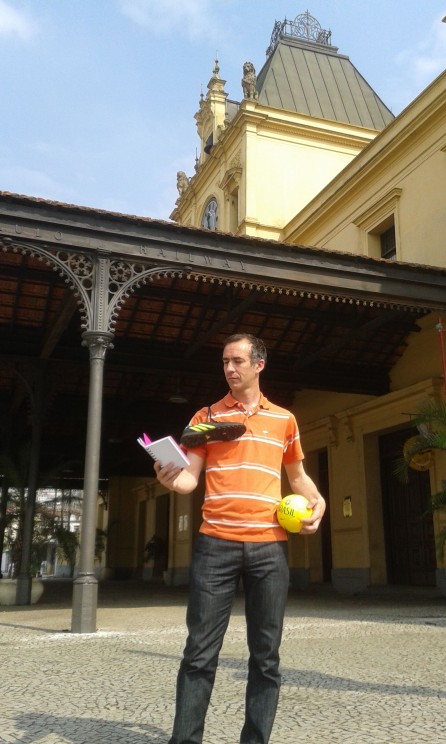
Opposite the passenger terminal, where the photo was taken, an old building is being converted into the Museu do Pelé, to house the history of Santos Futebol Clube’s most famous player, heralded by many as the greatest footballer of the twentieth century – though it will not be ready to open in time for the World Cup. The stories of Miller and Pelé are often linked to illustrate the development of football in Brazil. Gilberto Freyre, the Brazilian sociologist and historian, was one of the first:
‘[It was] Englishmen who introduced into Brazil the principal sporting and recreational replacements for our colonial jousting tournaments: horse-racing, tennis, cycling and football itself, which here became fully naturalised as a game not for fair-haired European expatriates in the tropics but for local people: […] people increasingly of varying shades of brown; with de-Anglicisation culminating in the admirable Pelé, after shining with Leônidas.
[Football] has become a veritable Afro-Brazilian dance, with footwork never imagined by its inventors. Has it stopped being British? Not in the slightest. Association football cannot be separated from its British origins to be considered a Brazilian or Afro-Brazilian invention. What it is, in its current, triumphant expression, is an Anglo-Afro-Brazilian game’. (Gilberto Freyre, The British in Brazil, London, 2011, first published in Portuguese in 1954, p.13.)

Charles Miller was born in São Paulo to a Scottish father and a Brazilian mother whose surname, Fox, reveals her English origins. During his lifetime the population of São Paulo ballooned from around 100,000 in 1874 to well over 2 million in 1953. Most of those new citizens were migrants and their children. São Paulo and Brazil were remaking themselves. Football and music became central ways for Brazilians to express a new inclusive identity after the abolition of slavery (1888) and the establishment of a new republic to replace monarchy (1889).
The sense of Brazilian football leaving its British origins behind as it headed for global domination on and off the pitch, as suggested by Freyre, is why there is no statue or plaque to Miller in the city, not even in the Praça Charles Miller, the square at the front of the Pacembu stadium which houses the Museu do Futebol. Though he was born and died in Brazil, and lived almost his entire life in Brazil (the exception was his schooling in Hampshire, England) Miller’s legend is that of an immigrant, stepping off the ship in Santos to begin a new life. His ambiguous identity, floating between Scottish, British and Brazilian might explain why his simple grave in the Cemeterio de Protestantes in São Paulo is so modest (a cross marked C.W.M, which the director of the cemetery asked me not to photograph, “out of respect”). The Museu Charles Miller, housed in the exclusive Clube Athletico Sao Paulo, and available to visit on appointment, contains old photographs, trophies and a letter from Pelé.
In Brazilian football historiography, “Charles Miller” has become a cipher for the elite, foreign origins of a game which was were subsequently embraced by the Brazilian povo (the people). Something similar is true of Alexander Watson Hutton for Argentina, a more conventional immigrant figure, a Scot who arrived in Buenos Aires as an adult and set about institutionalising and regulating the game of football through schools, teams and leagues. At the II Simpósio Internacional de Estudos Sobre Futebol that I attended in São Paulo last week, Miller was referenced by many of the researchers as a scene-setter to establish their credentials, his name alone enough to conjure images of moustachioed elite white men in blazers tapping a ball around.
At the Simposio, discussing museums and football with Richard McBrearty, director of the Scottish Football Museum, and Daniela Alfonsi, Diretora de Conteudo do Museu de Futebol, Kevin Moore, director of the [English] National Football Museum, noted that Miller’s story is ‘the very epitome of the multinational, global nature of the origins of football’. But they also pointed out that the origins of football were anything but a one man show. Hundreds of people played football in Brazil at the end of the nineteenth century, and historian José Moraes dos Santos Neto has argued pretty convincingly that football was being played in several places in Brazil before Miller’s much-heralded return from England. The ways in which Brazilians took on the game and made it their own is the subject of many wonderful books, including Alex Bellos’ Futebol: The Brazilian Way of Life and David Goldblatt’s Futebol Nation: A Footballing History of Brazil. The importance of Charles Miller lies not in any individual greatness but in the way that his story has captured something of the essence of being Brazilian, and of the ways in which football was adopted, regulated, internationalised and embraced around the world.
Dr Matthew Brown is a reader in Latin American Studies at the University of Bristol, and specialises in the history of sports in South America. In particular, the history of the very first football teams to be established. He contributed the biographies of Charles Miller and Alexander Hutton to Oxford Dictionary of National Biography’s May update.
The Oxford Dictionary of National Biography online is freely available via public libraries across the UK. Libraries offer ‘remote access’ allowing members to log-on to the complete dictionary, for free, from home (or any other computer) twenty-four hours a day. In addition to 58,800 life stories, the ODNB offers a free, twice monthly biography podcast with over 190 life stories now available. You can also sign up for Life of the Day, a topical biography delivered to your inbox, or follow @ODNB on Twitter for people in the news.
Subscribe to the OUPblog via email or RSS.
Subscribe to only history articles on the OUPblog via email or RSS.
Image credits: (1) Matthew Brown arriving in Brazil, impersonating Charles Miller, © Gloria Lanci. (2) Site of the forthcoming Museu do Pelé, © Matthew Brown.
The post Football arrives in Brazil appeared first on OUPblog.


By: Kirsty,
on 5/28/2014
Blog:
OUPblog
(
Login to Add to MyJacketFlap)
JacketFlap tags:
2010 World Cup,
hosting,
*Featured,
oxford journals,
blanco,
leagues,
football,
African economies,
Journal of African Economies,
tourism in africa,
iscar,
peeters,
szymanski,
matheson,
Economics,
soccer,
south africa,
tourism,
World Cup,
Add a tag
By Thomas Peeters, Victor Matheson, and Stefan Szymanski
The World Cup, the Olympics and other mega sporting events give cities and countries the opportunity to be in the world’s spotlight for several weeks, and the competition among them to host these events can be as fierce as the competition among the athletes themselves. Bids that had traditionally gone to wealthier countries have recently become a prize to be won by prospective hosts in the developing world. South Africa became the first African host of the FIFA World Cup in 2010, and this summer, Brazil is hosting the first South American World Cup in 35 years. Russia recently completed its first Winter Olympics in Sochi and will return to the international stage in 2018 when the World Cup heads to Eastern Europe for the first time.
On the surface, this might appear to be a leveling of the playing field, allowing developing countries to finally share in the riches that these events bring to their hosts. A closer look, however, shows that hosting these events is an enormously expensive and risky undertaking that is unlikely to pay off from a purely economic standpoint.
Because of the extensive infrastructure required to host the World Cup or the Summer or Winter Olympics, the cost of hosting these events can run into the tens of billions of dollars, especially for developing countries with limited sports and tourism infrastructure already in place. Cost estimates are often unreliable, but it is said that Brazil is spending a combined $30 billion to host the Olympics and World Cup, Beijing spent $40 billion on the 2008 summer games, and Russia set an all-time record with a $51 billion price tag on the Sochi games. Russia’s record is not likely to stand for long, however, as Qatar looks poised to spend upwards of $200 billion bringing the World Cup to the Middle East in 2022.

South Africa fan in Johannesburg during World Cup 2010
Why do countries throw their hat into the rings to host these events? Politicians typically claim that hosting will generate a financial windfall For example, the 2010 World Cup in South Africa, the focus of our paper, cost the country $3.9 billion including at least $1.3 billion in stadium construction costs. The consulting firm Grant Thornton initially predicted 483,000 international visitors would come to the country for the event and that it would generate “a gross economic impact of $12 billion to the country’s economy”. The firm later revised its figures downward, to 373,000 international visitors and lowered the estimated economic impact to $7.5 billion. Following the event, a FIFA report stated that “309,554 foreign tourists arrived in South Africa for the primary purpose of attending the 2010 FIFA World Cup.”
Our analysis of monthly tourist arrivals into South Africa during the months of the event, however, suggests that the tourist arrivals were even lower than this. The expected crowds and congestion associated with the tournament reduced the number of non-sports fans traveling to the country by over 100,000 leaving the net increase in tourists to the country during the World Cup at just 220,000 visitors. This figure is less than half that of Grant Thornton’s early projections and a full third below even the lowest visitor estimates provided after the tournament. We estimate that the cost to the nation per World Cup visitor lies in the range $4,700 to $13,000.
Our results provide a cautionary tale for cities and countries bidding for mega-events. The anticipated crowds may not materialize, and the economic gains from the sports fans who do come to watch the games need to be weighed against the economic losses associated from other potential travelers who avoid the region during the event.
Thomas Peeters is a PhD-fellow of the Flanders Research Foundation at the University of Antwerp. His main research interests are industrial organization and labor issues related to professional sports leagues. His work has been published in journals such as Economic Policy, the International Journal of Industrial Organization and the Journal of African Economies. Victor Matheson is a professor of economics at the College of the Holy Cross in Worcester, Massachusetts, USA. He is the author of numerous studies concerning the economic impact of major sporting events on host countries and is a member of the executive board of the North American Association of Sports Economists. Stefan Szymanski is the Stephen J. Galetti Professor of Sport Management at the University of Michigan. His research in the economics of sports includes work on the relationship between performance and spending in professional football leagues, the theory of contests applied to sports, the application of sports law to sports organizations, financing of professional leagues and insolvency, the costs and benefits of hosting major sporting events. They are the authors of the paper ‘Tourism and the 2010 World Cup: Lessons for developing countries’, which is published in the Journal of African Economies.
The Journal of African Economies is a vehicle to carry rigorous economic analysis, focused entirely on Africa, for Africans and anyone interested in the continent – be they consultants, policymakers, academics, traders, financiers, development agents or aid workers.
Subscribe to the OUPblog via email or RSS.
Subscribe to only business and economics articles on the OUPblog via email or RSS.
Image credit: South Africa fan in Johannesburg during World Cup 2010. By Iscar Blanco [Public domain], via Wikimedia Commons
The post Tourism and the 2010 World Cup appeared first on OUPblog.

By:
Sue Morris,
on 5/3/2014
Blog:
Kid Lit Reviews
(
Login to Add to MyJacketFlap)
JacketFlap tags:
Children's Books,
football,
Picture Book,
Favorites,
children's book reviews,
Books for Boys,
Michael Dahl,
Capstone Books,
Christina Forshay,
Picture Window Books,
5stars,
Capstone Young Readers,
football game,
quaarterback sacked,
SI KIDS,
Sports Illustrated for Kids,
Sports Illustrated for Kids Books,
Add a tag
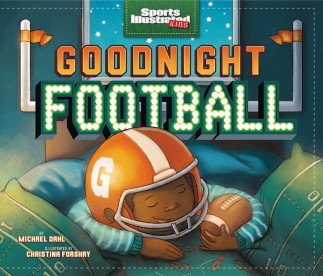 Goodnight Football (Sport Illustrated Kids)
Goodnight Football (Sport Illustrated Kids) 
by Michael Dahl & Christina Forshay, illustrator
Picture Window Books 8/01//2014
an imprint of Capstone Young Readers & Capstone Books
978-1-62370-106-2
Age 4 to 7 32 pages
.
“From the opening kickoff to the final whistle, Goodnight Football brings the excitement of a football game to the youngest fan. Rhyming text and vibrant illustrations capture the love of the game through a child’s eyes and celebrates the combination of football, friendship, and family.”
Opening
“It’s the end of the week,
it’s the best of all sights—
beneath the night sky
lies a field of bright lights!”
The Story Game
Tonight the home team Grizzlies are playing the Thunderbirds. The crowd bundles up to stay warm as they cheer on their team. It’s the first down of the game and Grizzlies quarterback, number 10, takes the snap, then takes a seat. He’s sacked! In the huddle, what will the Grizzlies do next? Number 10 throws the football long. A Grizzly player zips ahead of a thunderbird, passing by the tackle attempt, reaches up for the ball, and catches it—in the end zone! TOUCHDOWN GRIZZLIES! Through four quarters the teams race up and down the field, play after play, score after score. The final seconds tick off the clock as a Grizzly player dodges the last Thunderbird, running the ball run into the end zone for a touchdown and the game. It’s a Grizzly win for the hometown fans!
Happy Grizzly fans empty out of the field. The family of four walk past the field. The coaches are shaking hands, the players are saying ‘good game’ to their opponents, and the band says goodnight to the cheerleaders. The little boy waves goodnight to number 10, who smiles and waves back. The family heads home, but not before saying goodnight, and there are many goodnights to say. At the concession stand for one last order, the young boy waves goodnight to a new friend. Then it is off to the tour bus for the ride home, but not before waving goodnight to the Grizzly mascot, a giant orange bear! Then it is, “Goodnight goal posts” and “Goodnight moon.” Finally, home, it is past time for bed. The young boy has but two goodnights left. “Goodnight Mom. Goodnight Dad.” Then he drifts off to sleep, snuggling his football, dreaming of the next game, and making the winning touchdown.
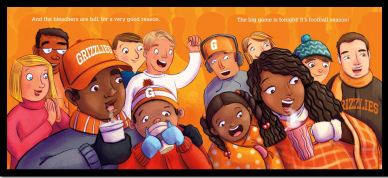
Review
Goodnight Football is the second bedtime sports adventure for young children from Sports Illustrated Kids. The first was Goodnight Baseball (review here). With Goodnight Football, the series has become multicultural. The African-American family is young with a small boy and girl. The boy is thrilled to be at the game. He waves to players, and smiles throughout the entire book, until bedtime when the yawns start in. I like that this is not the typical Caucasian family, as seen on the majority of kids’ books. The young boy is the one who says goodnight to everyone and everything. The game has exciting moments, nothing bad to sour the evening game. The home team is once again the winner and they probably will always win.
The cutest spread is the final one, with the young boy tucked into bed, eyes closed, snuggling his football. Having a younger brother who was football crazy at a young age I know the ending is realistic. Girls snuggle teddy bears; boys snuggle footballs and baseball gloves.
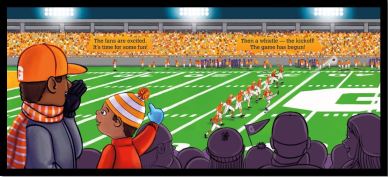
The colorful illustrations in Goodnight Football capture the game realistically. One spread in particular is the best. On the right side, the Grizzlies are in a huddle and the illustrator has you on the ground, looking up at the faces in the huddle. What is the play? That huddle is simply a nice image. On the left side, the sacked quarterback gets help rising to his feet. Just as these players do, the quarterback extends one hand to the player helping him up, who grabs the hand with both of his. The realistic image is terrific, but that is not why I love it so much. If you zoom into the middle of the image, right to the locked hands, you will see white hands helping up a black hand. I love the symbolism, which is why it is the best page in the book.
As with Goodnight Baseball, young boys, who will want dad to read the story at bedtime, will love Goodnight Football. The book introduces young kids to the game of football, gets them to notice the world around them, and make new friends. I love these sports books for the youngest boys. They are the ones who usually don’t get to play the game, but now they have something all their own. The story is an easy read, making it possible to read the story every night and not become annoyed with the book. Goodnight Football is a wonderful bedtime story for young boys, but some girls will love this story as well. Goodnight Football makes the perfect gift for young football fans.
GOODNIGHT FOOTBALL. Text copyright © 2014 by Michael Dahl. Illustrations copyright © 2014 by Christina Forshay. Reproduced by permission of the publisher, Capstone Young Readers, North Mankato, MN.
.
Learn more about Goodnight Football HERE.
Pre-Order Goodnight Football at Amazon—B&N—Book Depository—Capstone Books—your local bookstore.
.
Meet the author, Michael Dahl, at his website: http://www.michaeldahlwrites.com/
Meet the illustrator, Christina Forshay, at her website: http://www.christinaforshay.com/
Find more books at the Capstone Young Readers website: http://www.capstoneyoungreaders.com/
SI KIDS is a trademark of Time, Inc. http://www.sikids.com/
.
Also by Michael Dahl & Christina Forshay
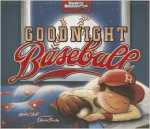
Goodnight Baseball (Sports Illustrated Kids)
.
.
.
.
.
Also by Michael Dahl
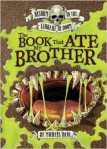
Book That Ate My Brother
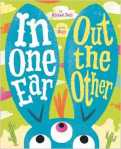
In One Ear, Out the Other
.
.
.
.
Also by Christina Forshay
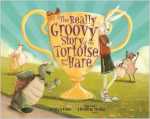
The Really Groovy Story of the Tortoise and the Hare
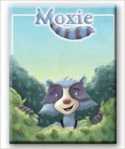
Moxie

Filed under:
5stars,
Books for Boys,
Children's Books,
Favorites,
Picture Book Tagged:
Capstone Books,
Capstone Young Readers,
children's book reviews,
Christina Forshay,
football,
football game,
Michael Dahl,
Picture Window Books,
quaarterback sacked,
SI KIDS,
Sports Illustrated for Kids,
Sports Illustrated for Kids Books 








By:
nicole,
on 3/24/2014
Blog:
the enchanted easel
(
Login to Add to MyJacketFlap)
JacketFlap tags:
the enchanted easel,
peyton manning,
denver broncos,
quarterback,
football,
love,
fan art,
birthday,
NFL,
Add a tag
to the most handsome, most classy, most humble and most amazingly awesome QB in the NFL! you are everything. I LOVE YOU PEYTON!!!
pure greatness. Super Bowl win or no Super Bowl win. this man is everything.
is it september yet???

By:
sketched out,
on 11/28/2013
Blog:
sketched out
(
Login to Add to MyJacketFlap)
JacketFlap tags:
SkADaMo,
Sketch a Day Month,
SkADaMo 2013,
illustration,
humor,
sketch,
sketchbook,
sketching,
Thanksgiving,
squirrels,
football,
drawing,
children's illustration,
acorn,
SkADaMo (sketch a day month),
Add a tag
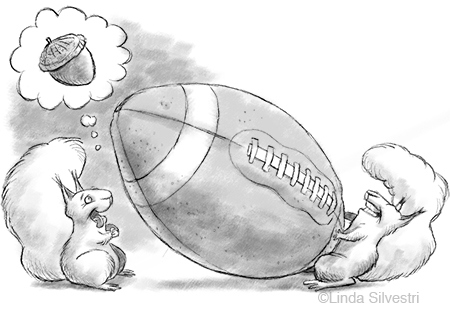
Today, we eat like kings!
An oldie from last year but seems appropriate for the day!
I’ll be back to SkADaMo tomorrow. But just in case there are some die hard SkADaMoeres out there, you can check here.



By:
nicole,
on 9/1/2013
Blog:
the enchanted easel
(
Login to Add to MyJacketFlap)
JacketFlap tags:
football,
girl,
sketch,
children's art,
blue,
cheerleader,
iris,
mermaid,
sea,
whimsical,
september,
sapphire,
mythical,
original painting,
the enchanted easel,
peyton manning,
denver broncos,
gemstone,
Add a tag
and September's sapphire haired beauty, Iris. she is available FOR SALE here:
i'll be posting little Opal (October's mermaid) in the next day or two. just have to scan her, as she's been done for a few days now.
September means FALL and wow, it can not come quick enough for me! this rain forest-like climate is a bit much. never liked summer. never will.
looking forward to all the smells of autumn (like pumpkins, apples, cinnamon...). speaking of pumpkins, i am already drooling at the anticipation of my first cup of pumpkin spice coffee from dunkin' donuts. OMG....SO YUMMY!!! and if that wasn't enough to excite me....
4 MORE DAYS TIL KICK OFF AND MY MAN PEYTON TAKING THE FIELD!!! SUPER STOKED!!!

By:
nicole,
on 5/9/2013
Blog:
the enchanted easel
(
Login to Add to MyJacketFlap)
JacketFlap tags:
football,
illustration friday,
sketch,
pencil,
tribute,
cheerleader,
whimsical,
the enchanted easel,
peyton manning,
pippa,
denver broncos,
Add a tag
i thought this was appropriate for this week's IF prompt *tribute*....my mad crazy love for mr. manning!
can't wait for football season to start!!!!

By: Nicola,
on 2/25/2013
Blog:
OUPblog
(
Login to Add to MyJacketFlap)
JacketFlap tags:
podcast,
football,
History,
Sports,
Biography,
UK,
World Cup,
moore,
pele,
odnb,
bobby,
*Featured,
footballer,
oxford dictionary of national biography,
oxford dnb,
Arts & Leisure,
Online Products,
1966 World Cup,
Bobby Frederick Chelsea Moore,
Bobby Moore,
football clubs,
Fulham,
odnb podcast,
West Ham,
moore’s,
Add a tag
By Daniel Parker
“My captain, my leader, my right-hand man. He was the spirit and the heartbeat of the team. A cool, calculating footballer I could trust with my life. He was the supreme professional, the best I ever worked with. Without him England would never have won the World Cup.” –Sir Alf Ramsey
Bobby Moore is an icon. He earned his place in football’s pantheon by captaining England to their only World Cup triumph in 1966 and his rightful place amongst the football greats is immortalised in bronze outside Wembley Stadium. He represented West Ham United over 500 times and was described by Pele as ‘the most accomplished defender [he has] ever played against’.
From the iconic image of Bobby Moore holding the World Cup trophy aloft to the famous embrace between him and Pele during the 1970 World Cup, from his loyalty to West Ham United Football Club to his brave struggle against bowel cancer in his later years, Bobby Moore represents a significant chapter in the history of world football. But what about the man behind the bronze? To mark the twentieth anniversary of his death (February 24), here are five things you might not have known about the man known as Mooro:

(1) Bobby Moore was a good footballer as a schoolboy but he wasn’t exceptional. In fact, he was a better cricketer than he was a footballer and for a while it seemed he was more likely to make it as a professional cricketer. He represented Tom Hood Grammar School in Leyton at both cricket and football, and played county cricket for the Essex Youth team. It was only after a few years did his football ability begin to shine.
(2) The England team that arrived in Mexico to defend the World Cup in 1970 were high in confidence. However, Bobby Moore was nowhere to be seen. He wasn’t with the squad as they arrived in Mexico. Instead he was being held in Bogota, Columbia, arrested and facing charges of stealing an emerald-studded gold bracelet valued at over £600. The ordeal Moore went through before joining up with his England team-mates is common knowledge. What is less widely known, however, is that he still faced those charges when he went to Mexico to captain his country at the World Cup. He arguably even played the greatest game he had ever played for England against Brazil in the quarter-finals, despite not knowing whether he would be found innocent or guilty by the Columbian police. He was later found innocent.
(3) Despite his fabled heroics with England, Moore’s club form never reached the same heights as his performances for the national team. West Ham had three England regulars in their side throughout the 1960s but they never finished higher than eighth in the league. It was suggested by his manager at the time, Ron Greenwood, that Moore concentrated harder on his performances for England than he did for West Ham. Although West Ham did win the FA Cup in 1964 and the European cup winners’ trophy in 1965, their star players, including Bobby Moore, were criticised for being ‘as erratic as dock work’.
(4) After his playing career Bobby Moore part-owned pubs and clubs across east London. Many of these were successful business ventures, notably Mooro’s, and his status in London’s east end helped these businesses flourish. However, he also was part of the failed sports marketing and promotion company Challenge. After only a few years, in the early 1990s, Challenge went into liquidation, an illustration that leading a nation on the football pitch perhaps came more naturally to Moore than leading a business.
(5) Bobby Moore’s last appearance in an FA Cup final wasn’t for his beloved West Ham United but against them. The season after Moore transferred from West Ham to Fulham, he guided Fulham to an FA Cup Final in 1975. Having led West Ham to FA Cup glory in 1964, it is ironic that Moore’s last club game in England in 1975 came against the side that he represented 544 times. West Ham ended up winning in a game that provoked mixed emotions for Moore. Also, not only did Moore play for Fulham, one of Moore’s middle names is Chelsea. It’s unlikely that many Hammers would hold this against him though.
To read more about the life of Bobby Frederick Chelsea Moore, please visit his biography page on the Oxford Dictionary of National Biography. Moore’s life story is also available as an episode in the ODNB’s free biography podcast.
Daniel Parker is Publicity Assistant for the Oxford Dictionary of National Biography.
The Oxford Dictionary of National Biography is the national record of men and women who have shaped British history and culture, worldwide, from the Romans to the 21st century. In addition to 58,500 life stories, the ODNB offers a free, twice monthly biography podcastwith over 175 life stories now available. You can also sign up for Life of the Day, a topical biography delivered to your inbox, or follow @odnb on Twitter for people in the news. The Oxford DNB is freely available via public libraries across the UK. Libraries offer ‘remote access’ allowing members to log-on to the complete dictionary, for free, from home (or any other computer) twenty-four hours a day.
Subscribe to the OUPblog via email or RSS.
Subscribe to only sports articles on the OUPblog via email or RSS.
Image credit: Bobby Moore statue by John Dobson [Creative Commons License via Wikimedia Commons].
The post Five things you might not know about Bobby Moore appeared first on OUPblog.


By:
nicole,
on 8/9/2012
Blog:
the enchanted easel
(
Login to Add to MyJacketFlap)
JacketFlap tags:
football,
girl,
cute,
cheerleader,
whimsical,
tinted graphite,
the enchanted easel,
peyton manning,
denver broncos,
sketch. pencil,
Add a tag
but it still counts!:)
just wanted to show my man peyton some love tonight (as we all know i have plenty of that for him!!!)
so, go kick some bears a**!!!
love, pippa
xxx
I’ll come straight out with it: I’m not a football fan.
But…
I am a fan of using whatever I can to get kids excited about books and reading.
So this week at school, in our story+activity enrichment session on Friday, it’s all about football (soccer) in the hope that Euro 2012 is fizzing rather than fizzling.
I’ll be reading three football-based picture books: Goal! by Mina Javaherbin and A.G. Ford, Pass it, Polly by Sarah Garland and Football Fever by Alan Durant and Kate Leake.

Goal!, set in a South African township, is about just how much fun playing football can be. Bullying and poverty also play a role in this book, which Archbiship Desmond Tutu has described as “uplifting and inspiring”. I’ve chosen to read it in school for its interesting setting and exuberance.
Pass it, Polly, by one of my favourite British author/illustrators, shows girls loving playing football just as much as boys. Polly and Nisha are determined to make it onto the school football team, and with a bit of practice and family support, they do indeed show everyone girls can make great footballers.
Football Fever is the most conventional, least challenging of the three stories (an anglo saxon family with a soccer mad son and father) but it is told with lovely humour, fun illustrations and a great punch line showing how football can excite anyone.
After reading the books we’ll be designing our own soccer strip and making footballing finger puppets. We’ll also be putting new designs on footballs and then playing footie on the classroom tables…

The template for the finger puppets can be found here (there are both boy and girl footballer templates). You may need to make the finger holes a little larger depending on the age of your kids. I’ve photocopied the templates onto white card. The kids will use ordinary pens and pencils to colour them in before cutting them out themselves (I’ll use a craft punch to make the finger holes – speed is of the essence when you’ve 30 kids on the go).

For footballs I’m using pingpong balls (I was able to find 12 pingpong balls for £1 in the pound shop), and we’ll be using permanent pens (Sharpies) to draw our designs onto the balls.
 3 Comments on Using football fever to get young kids excited about books, last added: 6/14/2012
3 Comments on Using football fever to get young kids excited about books, last added: 6/14/2012

by author Travis Nichols
Matthew Meets the Man is set in an unnamed mid-sized city in Texas, similar to my hometown of Abilene. It's a part of the country where much of the year revolves around football. You don't have to be on the team or even be interested in the game. From dances to marching band competitions and beyond, football is the center of attention. I was never into football, but I participated several times in a tradition that I only recently discovered isn't well-known nationally.
In Texas and Oklahoma (and apparently some parts of Louisiana and Arkansas), the most grand and opulent of football-related traditions is THE HOMECOMING MUM. In the '70s, a guy would pin a chrysanthemum on his main squeeze's blouse for homecoming. How quaint. As time passed, the real flower was replaced with a fake, and ribbons and charms sprouted out in greater and greater numbers. Then, the double mum. Then, the triple mum.
Then, stuffed animals. Neckstraps became necessary. I've seen recent photos of mums with LED lights. SPEAKERS. Sure, you can still buy/make a more modest mum for $30 or so, but what's the point? If she doesn't need a back brace after, what does that say about your affection?
I was visiting Texas in the fall, and I took photos of part of the mum-making section at a craft store. Repeat. Part of the mum section. Do an image search online to see more of the glorious madness.


RECOIL IN (SCHOOL-SPIRITED) HORROR. Note: the first image is of pre-charmed mums.
I love telling people about homecoming mums, so I knew early on that I HAD to include mums in Matthew Meets the Man. In the book, to avoid depleting his drum fund, Matt makes his date a skimpy nothing of a mum. His mom sees it and does NOT approve. He adds to it and ends up with something that is on the tasteful end of the spectrum.

Matt's friend Greg makes a mum for his date, and it's a whole different animal. Hint: the illustration takes up a page and a half.
Looking back on my pre-teen and teen years in a football town while writing Matthew Meets the Man was a lot of fun. Sure, I never cared about football, but the traditions and energy that surrounded the games was a great part of growing up. Most importantly, immortalizing the mammoth mum my friend Kip (who, um, in no way is, ahem, er, the basis for 'Greg') made for his girlfriend one year makes me feel like I accomplished something really special with my life.
In your face, Kip. In your face.
A conversation with editor Nancy Mercado & author Paul Acampora about squirrels, books, football, writing, ice cream, the Pope and Rachel Spinelli Punched Me in the Face
Nancy: When I look back at all the drafts of Rachel Spinelli Punched Me in the Face, I’m amazed at how in each rewrite you start the book in a totally new place! How did changing the opening change how you saw the book?
Paul: Looking in my files, I see that there are more than 30 separate versions of this novel with half a dozen different titles. YIKES! Originally, the main relationship in the story was going to be the one between Rachel and her brother, Teddy. But even in my very first drafts, Teddy was so complete. He doesn’t need to change. And it’s really hard to find a novel’s worth of story if change is not a necessity or even a possibility for a main character. But I just loved these people, and I really wanted to spend time with them so I just kept writing and writing. Glancing at the various openings now, I see myself moving the more complicated relationships in the story to the center of things. By the final version, I knew whose heart I wanted the reader to be closest to so I was working to create a beginning that (hopefully) gives sense to every action and choice that the main character makes throughout the story.
Nancy: What did you learn (if anything!) by writing all of those different beginnings?
Paul: I learned that “good” writing is not enough. The other beginnings are really not that bad. Some of them are livelier or funnier or more exciting than the final version. Some of them I like just as much (or even a little better!) than what’s there now. But they didn’t serve the story I wanted to tell. So I had to throw a lot of perfectly good scenes into the shredder.
Nancy: When you got to the current beginning (Zachary talking about moving from Colorado) did it just click into place for you and feel right? Or were you just tired and worn down from all the revising? (Ha!)
Paul: I think the “click” happens just before I start working on a final version of anything. I seem to spend a ton of time wandering around with my characters. I’m writing stuff, but I kind of know that I’m not getting to the “real” story yet. Then one day I hear a song or read a magazine article or see a photograph or overhear a playground argument or just have a conversation with you… and suddenly I know exactly where I should be going. That’s when the writing becomes really fun! As far as getting worn down from the revising, that’s exactly the opposite of what happens! Revising moves me closer and closer to the heart of what I’ve been trying to get at. It’s satisfying and exciting and even a little scary. But that’s where I want to be!
Nancy: Have you ever been punched in the face? Either metaphorically or physically?
Paul: Believe it or not, I played high school football. I was the worst football player in the history of southern New England. I’m talking about a geographic region seriously not recognized for gridiron prowess, so believe me when I tell you that I was not good. Not good at all. I was too small to play up front, to wishy-washy to remember the plays, too ham-fisted to catch the ball, too slow to keep up with receivers, and when I was involved with any kind of hitting, I’d often jump up and down and yell, OH MY GOD THAT HURTS! (Football coaches hate that.) Also, if I accidentally tackled somebody, I’d help them up and then ask if they were okay. (Football coaches REALLY hate that!) In any case, every play felt like getting punched in the face during a forty car pile-up. I really don’t know why I played the game.
Nancy: What was the most important thing to you when writing this book? In other words, what did you most want to accomplish
 So when Made by Raffi written by Craig Pomranz, illustrated by Margaret Chamberlain (@madgiemadge) appeared in my hands for the first time I sat up and noticed; it’s about a boy who feels he doesn’t quite fit in, for instead of football, his passion is knitting and sewing.
So when Made by Raffi written by Craig Pomranz, illustrated by Margaret Chamberlain (@madgiemadge) appeared in my hands for the first time I sat up and noticed; it’s about a boy who feels he doesn’t quite fit in, for instead of football, his passion is knitting and sewing.































.jpg)



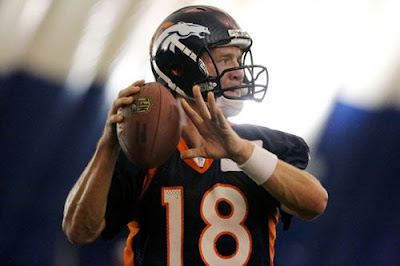

























Yay! We’re big fans of crochet round the shelf, but I never realised there were so many fiction books for littlies featuring knitting. Thanks for the heads-up!
You know, I couldn’t think of one book. This looks wonderful, and that list of knitting books, my granny would have been so amazed by them. Thanks so much for sharing them with us.
What a great list of knitting books. One of our favourite knitting stories is The Best Jumper by Lynne Garner & Sarah Gill.